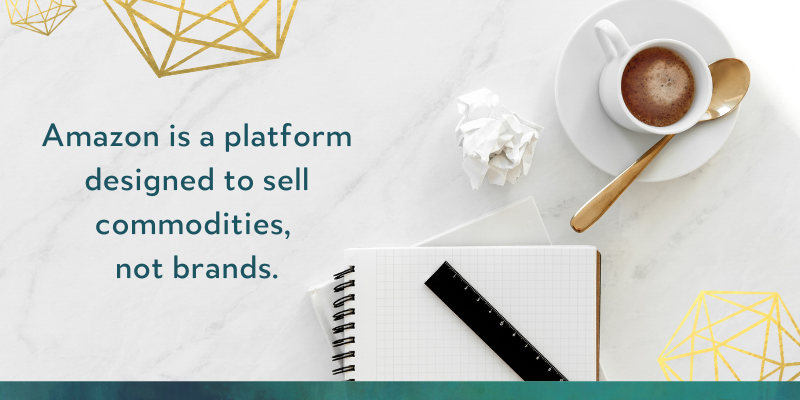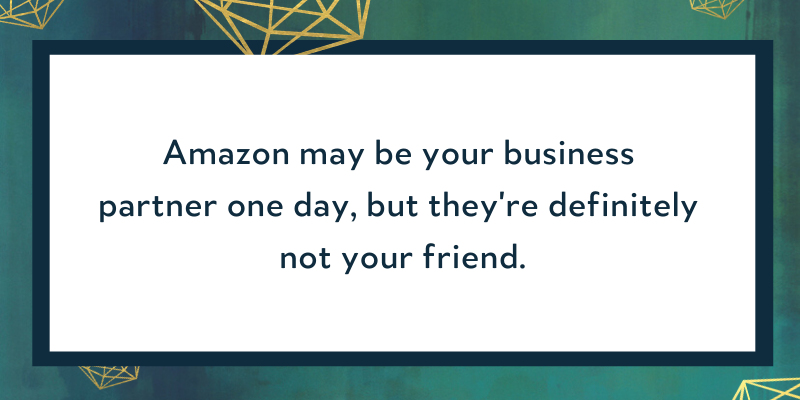In 2016, I wrote a blog exploring whether or not selling on Amazon was worth it. At the time, Amazon Handmade was in its infancy, and artisans were buzzing with optimism and excitement. I proffered my opinion in the “Amazon Handmade versus Etsy” debate. And holy smokes did the internet have an opinion! LOTS of opinions, in fact. That blog about the pros and cons of selling on Amazon has garnered more comments than any other in this site’s seven-year history. Four years on, I imagine that we’re due for an update.
SELLING ON AMAZON IN 2020
As Amazon’s meteoric rise continues unabated, the retailing juggernaut seems to be perpetually on the minds of makers and artisan product designers in the Lucky Break community. Today I’m wading back into the debate in hopes of answering the question: Is selling on Amazon worth it in 2020? Before I strap on my fire-retardant panties, I’d like to offer a gentle reminder.
I publish this blog with artisan brands in mind. If you’re marketing an invention or a commodity or reselling the products of others, then your mileage may vary. My clients are brand owners who are either making their products in small batches or outsourcing the production in limited runs. By and large, they’re aiming to build a diversified, sustainable business rather than looking for the swiftest path to quick cash. They’re thoughtful about how and where their products are presented, and how well one sales channel complements another. If you’re not among that population, then your perspective might be quite different- and we can agree to disagree.
I won’t deny that Amazon is a behemoth. Perhaps even the wave of the future, and an apt (though sometimes uncomfortable) reflection of modern society. Yet I still recommend that artisan brands steer clear of Amazon. Here’s why…
AMAZON OWNS THIS CUSTOMER AND CONTROLS THE COMMUNICATION.
When you receive an order, the buyer’s mailing address is visible through the Amazon portal. What’s not visible? The buyer’s email address, and that’s by design. Amazon’s Seller Code of Conduct explicitly
- Disallows the sending of unsolicited communications,
- States that no contact is allowed except through Buyer-Seller Messaging system,
- Prohibits any attempt to circumvent the Amazon sales process.
What that means for you, dear friend, is that this is a one-time sale as far as Amazon is concerned. This customer belongs to them, and they plan to keep it that way.
But why does that matter? I consistently caution my clients to “own their customers” whenever possible, rather than putting their eggs in the baskets of Etsy, Faire, or Amazon. These third-party entities aren’t interested in growing your audience- they’re looking to secure a financial transaction. Once that’s done, the portal to the customer closes, and the seller finds themselves shut out, unable to proactively market to the individual who just bought their product.

Instagram can change its algorithm tomorrow, diminishing the audience who sees each post. Faire can alter its commission structure. Etsy can penalize those sellers who don’t advertise with them or offer the type of customer incentives they’re favoring these days. Putting the lion’s share of your efforts into these platforms is essentially making yourself a brilliantly-colored flamingo standing in the middle of a muddy marsh, surrounded by velociraptors. One sweep of the knee, and you’re done.
A better approach than selling on Amazon, Faire, or Etsy? Invest the majority of your energy in platforms where you own the customer and are the master of your fate. You can do that by creating a visually compelling, easy-to-navigate, intuitive e-commerce site, and then marketing the hell out of it. Make collecting email addresses a primary aim, and then put them to good use by regularly reaching out directly to your customers with meaningful content of interest.
That’s not to say that Instagram, Faire, and Etsy don’t have value for makers- quite the contrary. They can all be smart tools for growing your business, but I leave Amazon out of that toolbox completely.
SELLING ON AMAZON ERODES BRAND POTENTIAL.
“I got it on Amazon.”
That’s the honest answer that frequently tumbles from the mouths of Amazon’s most avid shoppers when asked where they scored their latest find. And it’s true- whatever they just purchased was procured through Amazon. But that does nothing to raise brand awareness or build the credibility of your brand. And where will they go when they need their next thing? Amazon, of course.
But can you blame consumers? Amazon can deliver virtually anything to your doorstep within two days (increasingly, within one) and for less than you’d likely pay elsewhere. That’s a compelling proposition for American consumers who like things fast, cheap, and accessible. And while you’ll frequently find an Amazon Prime package sitting on my doorstep awaiting my arrival, you won’t find my products sold there.
And you won’t find Nike products there anymore either. Nike recently announced that they were plucking all of their products from Amazon.

Brands build customer loyalty by offering differentiated products enriched with emotional resonance. Commodities deliver virtually indistinguishable products that are quick and easy to access, and the price is the primary driver. Brand and commodities can’t co-exist in one marketplace. Which means you toss the branded products that you’ve created with blood, sweat, and tears onto Amazon, they become commodities. Not bought from you. No chance to build loyalty and trust. Little hope of a recurring sale. Competing on price with all the other eye creams, ceramic planters, leather clogs, chandelier earrings, and handbags that just arrived in port from abroad. Ouch.
Amazon forums are currently flooded with complaints from sellers who argue that the platform is increasingly leading customers away from branded searches. One Lucky Break client recently noted that an Amazon search for her company name brings up dozens of results, most of which have nothing to do with her offerings and many of which aren’t even in her product category. But once she has a potential customer in her “shop” and they click her company name to see more of her products, they get nothing but her products, yes? Nope! Click her brand name, and you’re shown a variety of products from her and from her competitors, too. Amazon continually reintroduces competitive products to browsing consumers because their aim is to convert the browser to a buyer each time they visit the site. It’s not to sell your product. It’s to sell any product.
RETAILERS AREN’T THRILLED TO SEE THEIR BRANDS ON AMAZON.
Ask retailers how they feel about Amazon, and their groans will occur with the same frequency as hyperbolic Trump tweets. In other words: frequent and predictable.
Boutique owners who pride themselves on thoughtful curations of often-undiscovered products are understandably miffed when they see those same products emerge for sale on what is- by any measure- the world’s largest selling platform. By hopping onto Amazon, sellers open the floodgates to access while cannibalizing their current retailers on price. That’s not a recipe for long-term success in the world of retail.

Appearing on Amazon is often a dealbreaker for buyers. In my 2019 interview with Max Rhodes (CEO of Faire), he revealed that “not on Amazon” is the platform’s most popular search filter. Buyers use it to filter out products which appear on Amazon in favor of brands who have steered clear.
Grocery stores and even department stores are fairly compatible with Amazon. But boutique buyers and spas will typically opt for brands that are more selective in their choice of distribution channels.
THESE ARE CUSTOMERS YOU MIGHT NOT WANT AND RULES YOU PROBABLY WON’T LIKE.
I say this as an Amazon customer myself, so I implore you to take heart if this next bit ruffles the feathers.
American consumers are a special kind of demanding- we want free shipping, quick-as-lightning delivery, the lowest possible price, and instant support on everything from our toothpaste to our textbooks. Amazon can deliver on all of that, and it’s feeding the beast of modern consumerism. But while small businesses are the backbone of this economy, we can’t possibly employ a fleet of at-the-ready delivery vehicles (better yet: drones!) or buy in the kind of “real-life boatload” quantities needed to slash margins to the bone and still survive.
Amazon has spoiled the American consumer, and trying to serve customers accustomed to those benefits is a special kind of hell. I have zero doubt that artisan brands can “outserve” Amazon all day every day. We do that by being authentic, sharing our stories, tending to our customers one-by-one, and showing our appreciation for them. We do it by letting our audience peek inside our businesses and building companies that reflect our values. That’s where we can compete and win. Not on speed. Not on pennies spent. But on values and ethics. If the amount of chatter I hear from clients denouncing fickle, demanding Amazon customers is any indication, then trying to serve an Amazon-minded audience as a small business is often an exercise in futility.

Even if you’re willing to roll up your sleeves and dive in with Amazon, I hope you won’t expect them to roll out the red carpet for you. There are constant complaints that Amazon consistently sides with customers in moments of dispute. Many sellers grumble that they’re buried in search results and can’t get traction unless they pony up additional funds to run ads on the platform. Stories of lost shipments destined for Amazon fulfillment centers are legendary, as are tales of delayed payments. In my last blog exploring the pros and cons of selling on Amazon, I shared that Amazon threatened to boot a long-established retailer if they didn’t drop their prices by 15%- a sum that Amazon felt comfortable dictating to the brand owner. The complaints have reached such a fever pitch that they’ve caught the eye of the FTC chairman and spawned articles which decry the “byzantine rules” that govern an “algorithmically policed global bazaar rife with devious plots to hijack listings for novelty socks and plastic watches.”
With “friends” like that, who needs enemies?
AMAZON HAS A HISTORY OF CLOUDY ETHICS.
While consumers continue their love affair with a platform that transacted an astounding 175 million items in a single 36-hour window in July of 2019, the ethics behind Amazon continue to draw criticism. Analysts argue that Amazon treats its workers like robots, emphasizing speed of delivery over worker safety while exploiting its labor force. Platform ethics ultimately co-mingle with brand ethics when brand’s elect to play in Amazon’s sandbox. Lines blur and conflicting marketing messages emerge when, say, an apparel brand that promotes itself as “anti-fast fashion” hops into bed with a marketplace that scores precious few points with workplace ethicists.
Amazon has also taken quite a bit of heat for “borrowing inspiration from consumer trends” to launch their own derivative products. They famously ripped off Allbirds wool sneaker design in 2019 and Williams Sonoma’s orb chair in 2018. Couple that with fears in some corners of the internet that the platform is keen on becoming a monopoly, and one could be forgiven for being a bit gun-shy when it comes to Amazon.
Jeff Bezos, however, is “all in.” The founder of Amazon is now worth more than $100 billion dollars and he spent most of 2019 arm-wrestling Bill Gates for the title of “world’s richest man.” I don’t begrudge the gentleman’s money and I’m an avid capitalist, but I do believe that with great power comes great responsibly.

And then there’s this elephant in the room: what is Amazon doing with all this data? At this point, Amazon knows about as much about my life, friends, important historical dates, and buying preferences as Facebook. They’re the keepers of a shocking amount of data (from how quickly I go through a roll of toilet paper to which self-help books I’ve read), and I worry about that much data in the hands of a company this ambitious, this profit-centric, with this history of privacy concerns. I’m married to a man who’s spent his 25-year career at the leading edge of the tech world, so perhaps that explains my natural pessimism. I love technology and data as much as the next Gen Xer, but I don’t talk to Alexa, I don’t know the genetic influences of my ancestors, and I don’t sell on Amazon.
HOW DO YOU FEEL ABOUT ON AMAZON?
I’d love to hear your perspective! Leave a comment below, and I look forward to the conversation- regardless of whether your Amazon’s biggest fan or loudest critic.










This is a fantastic article. Another related article I read discusses how Nike and other brands are pulling from selling on Amazon because of brand erosion and counterfeits. It’s the one major sales channel where they don’t have any control over how their brand is presented, so in an effort to preserve their premium brand experience, they are pulling from Amazon.
I’m not at all surprised! Here’s a link to an article regarding Nike’s decision in case anyone wants to learn more. >> https://www.businessinsider.com/nike-stops-selling-amazon-2019-11 I’ll update the post to reflect this as well. Thanks, Angie!
Absolutely love the “spoiled the American consumer” line! And, what about the fact that Amazon helped bring about the demise of brick and mortar stores (specifically bookstores) only to now be opening brick and mortar stores (including bookstores) of its own.
I have a love/hate and general self-loathing relationship with Amazon myself. While I am environmentally conscious, I buy my vitamins from Amazon one day then realize I’m out of magnesium two days later, so back to Amazon I go. I receive both shipments separately in two separate insanely oversized packages considering the size of the goods comtained within.
Amazon could change its tagline to “allowing apathy through convenience”.
The tagline works both for training customers to be brand agnostic and also unaware of the impact fast (and “free”) shipping has on the planet.
Love the article (and the old one from 2016) Etsy is pretty much going the same route. Bombarding seller with free and faster shipping requests. If you have ads with Etsy and you get a customer to your shop they entice them with other seller’s products sneakily with a banner at the bottom so it isn’t even clear they are not your products.
The data mining however is almost impossible to avoid unless you stopp all connections with the internet & phone 🙂 I have given up on that…
Thank you Lela, great article. You’re the best. I sold on Amazon for about 3 years up until about 4 years ago. Most people order 1 item and my brand depends on customers expanding into more products of our line. I want brand loyalty and didn’t find it on amazon. And with the fees and the hassle of selling through them, it was clear it was not a win for my business. Now I wouldn’t sell through Amazon because of their ethics and it’s basically running so many local businesses out of business. Amazon’s philosophy is in direct opposition to my business philosophy so I just do not want my business to have anything to do with Amazon.
I love this “fire-retardant panties” that made me laugh so hard, which is what I needed right now 🙂 I also love all your thoughts, opinions and the facts you list on here. It really gets me to thinking. As one of my goals for 2019, I wanted to start selling on Amazon. I applied, updated my page and profile and even listed an item with a quality of 1. It was basically a holding spot until I could get ready to list more items at once. But something kept stopping me every time I would think about adding items. I never could put my finger on it and so nothing else got added or updated. I think what you wrote in this post is a lot of what I was feeling and thinking over the year that kept stopping me. I did add it on my 2020 goal sheet, but I think after reading this that Amazon is not the way to go for my shop dolphinwoodhouse.com Now to find a goal to put in its place 🙂 Thank you for your time in writing and informing us 🙂
Yes! You’ve spoken to every single reason behind my own decision to never shackle my brand to Amazon. They are only interested in making a sale, and actively degrade the companies that do business through their platform.
It’s for many of the same reasons that I hold my brand’s presence on Etsy with an open hand as well; for now, it is still profitable to be there, but every major change they make seems to tip me closer to the line where I will pull Dear Summit off their site, too.
When you look at these websites as platforms or marketplaces you can use (or not) to grow your brand outside of your own website – rather than THE place to build your brand’s home – it forces you to think more carefully about whether they’re actually worthwhile.
THANK YOU for saving me from another heartache. I don’t need more problems. It is so tempting to go down that ‘Amazon’ path, but I just don’t see that it will really be where I need to be. You have always given us the best information. I appreciate your help.
Their in-house brands are ripping off other brands left and right. Their furniture lines Stone & Beam and Rivet are West Elm or Article knockoffs. I’ve also heard plenty of stories about them sourcing popular one-off products from overseas manufacturers and then directly competing with sellers.
We’ve also experienced retailers telling us that they prefer products that aren’t sold on Amazon. They have a hard enough time competing with Amazon as it is, and know that their customers are just as likely to pull out their phone and look for the product online if it’s available. Some retailers straight up wont buy from a maker if they do sell there.
Hi!, I really found your article interesting. After reading it, I think I will avoid Amazon. I have a VERY small home textiles business which I started several months ago. Selling has been by word of mouth so far, and I have been contemplating the next step. I briefly had an ETSY shop , but found the sheer volume of products available made it difficult, as well as the fact that so many of those products appear to be made en mass rather than by an artisan or craftsoerson. So maybe a good quality craft market or approaching a store might be better. I’m not looking to take over the business world, but I would like to have a legimate business. Thank you very much for your informative article.
Great article! Thank you saved me from selling on Amazon handmade! and helped me make up my mind about my own website..cant thank you enough.
I am already selling on Etsy , however its getting expensive , as it costs me almost 35% when all the costs adds up ! which makes my handmade jewelry with Natural Gemstones very pricy . They have a new feature where Etsy off site adds (which i don’t understand)!.
To make a long story short I will continue selling on Etsy with minimum items on there and try and divert the customers to my website (the one I don have yet 🙂 . I can perhaps send the website details when i post the items i sell , where the price will be less than Etsy as it will be at least 25% cheaper .
Will look out for more articles. Cheers
I agree with all of the things that you shared. Unfortunately for me, sales on my own website completely stopped since the Covid lockdown. My followers have actually messaged me to let me know that they won’t be buying for a while since they were laid off. I completely forgot that I even had items listed on Amazon Handmade since I input them years ago and did not make any sales, but orders exploded a few months ago. I think it’s because people are going crazy shopping on Amazon. Since my handmade business is my full time job, it’s been both a blessing and a curse because it is allowing me stay afloat, but I feel like I’m selling my handmade artist’s soul to the devil or something and I hate this feeling like I have to do anything and everything to stay on Amazon’s good side, if that makes sense. I wish that I could figure out how to reach new customers who want to buy my items somewhere else other than Amazon.
I’ve debated selling on Amazon. Heck, I even created a Handmade account for my photography. Your article confirmed many of my suspicions and highlighted a few of my own experiences. I’ll not be selling on Amazon. I’ll stick to my little website.
Thank you for the article! I live in Vancouver, Canada. I just got approved by amazon to sell my handmade, beeswax candles. But I think I won’t pursue it. Ethics is extremely important to me and since I have a full time job, I can be quite content with a small website and maybe an Arts stand somewhere.
You’re right and wrong.
Right that platforms that harness less control over brands, like Etsy, offer street cred to us handmade folks. There’s a big wrong here though…if you want to continue to sell through with meh sales, you can’t avoid amazon. Amazon converts if you work at it. Sure, the fees don’t make sense but hell, they’re transparent about it; build it in, lower your margin. I’ve yet to meet one true entrepreneur who doesn’t re-evaluate margin based on performance on platform, product, ect…
Change your thinking per platform. On etsy, it’s cool that you get to actually engage with the customer. I love it sometimes. Other times, I just want the lonely tire kickers to buy or take off, eh…(I swear I’m not Canadian…:O)
Here’s where I’m at…I have a few hundred thousand skus on amazon. They convert anonymously. I honestly don’t care about the brand more than the buyer. I donate part of each purchase to my church but no one really knows that’s true except me and my church. I sell hard on Amazon.
Etsy is tough. You have to choose what you want to be because most people who will find this page will agree with you and determinedly fight against the big awful mess and bully that Amazon is. What is my reality is that you can do both and I implore entrepreneurs to do just that. Don’t think because you care others do; you’ll be disappointed. Fight. Fight like hell or get left behind with your laurels. I love to follow passion because it’s easy. It’s damn hard to follow your gut and convert instead.
Great article. Coffee on me next Toronto visit.
Pingback: Ultimate Guide to Sustainable Amazon Alternatives for Everything